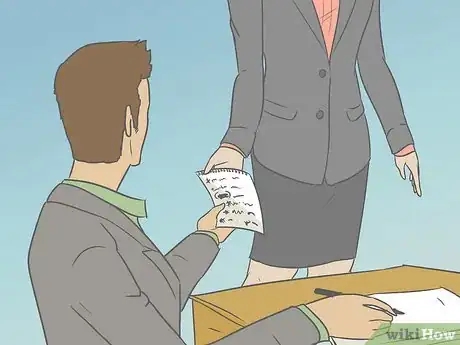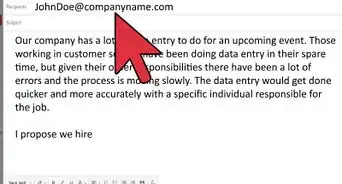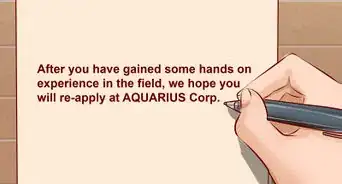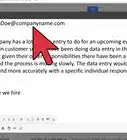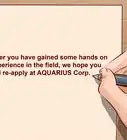X
wikiHow is a “wiki,” similar to Wikipedia, which means that many of our articles are co-written by multiple authors. To create this article, volunteer authors worked to edit and improve it over time.
This article has been viewed 22,361 times.
Learn more...
As a business owner or manager, one of your primary tasks is workforce management. It's highly important that you maintain the right number of employees to smoothly run your company. The need for hiring more employees depends not only on how many people, irrespective of the reason; leave your company, but how rapidly your business is growing. Hiring the right individuals at right time is crucial to your business' success.
Steps
Part 1
Part 1 of 3:
Considering the Possibility of Hiring Someone
-
1Evaluate the potential employee's work capacity. Calculating the capacity at which the new employee would operate will help you to figure out whether to hire a new employee or not. You should only consider hiring a new employee if you can ensure they will be working at 60 to 80 percent of their potential capacity.
- If someone you hire will be operating at below 60 percent capacity, then it's not a worthwhile investment decision over the long-term.
- In scenarios where additional help is still needed, despite the fact that your permanent employee is not fully occupied, consider hiring a temporary worker or a contractor.
-
2Look at the competitive landscape. Since a fierce competition for talent exists in today's job market, certain industries never turn down the opportunity to hire skilled workers.
- For example, companies in the manufacturing sector don't take the risk of losing out on a skilled worker to their competitor, regardless of whether they currently have enough work for that person or not.
- In many rapidly moving industries, such as telecommunications, ongoing hiring occurs. Other fast growing industries include: beverage manufacturing, software development, support services for mining, oil, seed and grain farming and many others.
- These industries all require a consistent supply of additional employees to meet business demands.
Advertisement -
3Determine your company's profit goals. You need to see whether the cost of hiring additional workers eats into your profits or not.
- Hiring additional workers at the right level of productivity matters, therefore, based on the unique conditions of your business, you should calculate the gross-profit-per-labor-dollar-spent. This calculation should be done for both low-wage and higher-wage workers.
- Simply put, you should generate a return on an employee's salary in sales within a pre-defined time period.
Advertisement
Part 2
Part 2 of 3:
Recognizing When You Need to Hire Someone
-
1Watch out for the signs that you need to hire someone. A lot of employers are unwilling to admit there is a need to hire additional employees until things are visibly out of control. However, there are certain signs you need to watch out which indicate that additional hiring is necessary.
-
2Take note if your employees are consistently doing long hours at work. If your employees are consistently spending additional time at work beyond the normal working hours, which is solely spent on official tasks, you should consider taking someone else on to lighten the workload..
- Being devoted to your job is fine, but if your staff hasn't taken time off to go on vacation for almost a year, it signals additional employees should be hired.
-
3Consider whether your email inflow has been out of control. When your inbox is flooded with not spam but legitimate emails, this is a sure sign that your response rate to emails not quite what it should be.
- If almost 25% of your daily working hours are spent responding to emails, you are most likely behind on meetings and other important responsibilities.
- Since most people expect a response to their email within 48 hours, you should hire a part-time employee to answer your emails to free up time for important tasks.
-
4Think about whether you've been receiving increased complaints from over-worked employees. If your staff is overwhelmed with work and they feel a burnout situation, many are likely to quit their job in the long run. Such a stressful environment will not allow employees to be as productive as required.
- If your staff is underpaid and overworked, it's your responsibility as an employer to ease their burden and hire additional employees.
- If hiring permanent employees is not an option, consider engaging contract employees who can get work done at a low cost.
-
5Look for frequent occurrences of missed deadlines and meetings. It is a big indicator that now is the time to hire additional employees if you are consistently missing deadlines and important meetings.
- Missed deadlines or meetings not only put a question mark on your performance, but also give a bad impression to prospective clients who may ultimately lose confidence in your ability to meet their expectations.
- In this scenario, additional employees can help you to manage your schedule so you can competently handle significant business matters.
-
6Take note if routine work is not organized or streamlined. When much of your work day is spent in a chaotic and fire-fighting mode, your routine tasks need reconsideration. When you see work getting piled up despite your efforts to keep it as organized as possible, it signals you need to hire additional employees.
- Most companies fail to recognize this need until they are audited by an external body and panic mode sets in to find the required documents or emails.
- You can easily hire a part-time employee or an intern to organize your documents and carry out other time-consuming but menial administrative tasks.
Advertisement
Part 3
Part 3 of 3:
Identifying Your Business's Needs
-
1Consider whether your company is growing and expanding. If your company is performing well and acquiring new business accounts or many small projects, there is a need to expand your working staff.
- In order to meet client requirements, it is advisable to hire enough staff so you can offer the desired service level without any dip in quality standards.
- When you start offering new services or add new locations to your business portfolio and your current staff cannot carry additional workload, you should consider hiring either temporary or permanent employees or a mix of both employee groups.
-
2Think about whether your business would benefit from hiring employees with specific skills. As your business grows, you may temporarily rotate current employees, but they may not possess the skills required by the new project.
- In such a situation, you cannot compromise on meeting client requirements - you have to show both efficiency and effectiveness.
- Hiring additional staff becomes a need, especially if the new account runs on technology not available in your company. This translates to hiring technology experts to train staff and new employees who can operate the new technology to achieve business goals.
Advertisement
References
- http://www.businessknowledgesource.com/blog/how_to_know_when_you_need_to_hire_more_employees_030145.html
- http://www.nfib.com/article/dont-hire-an-additional-employee-until-you-check-these-3-things-61503/
- http://www.entrepreneur.com/article/81244
- http://www.forbes.com/sites/sageworks/2013/12/29/industries-to-watch-in-2014-the-10-fastest-growing-fields/
About This Article
Advertisement















